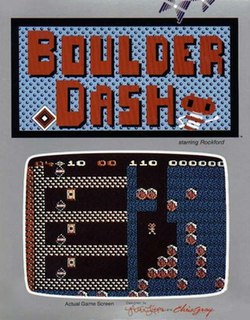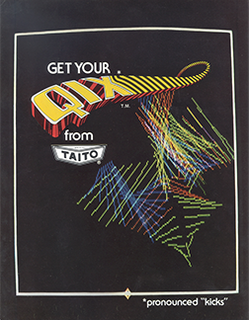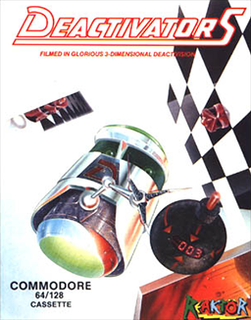
Maniac Mansion is a 1987 graphic adventure video game developed and published by Lucasfilm Games. It follows teenage protagonist Dave Miller as he attempts to rescue his girlfriend Sandy Pantz from a mad scientist, whose mind has been enslaved by a sentient meteor. The player uses a point-and-click interface to guide Dave and two of his six playable friends through the scientist's mansion while solving puzzles and avoiding dangers. Gameplay is non-linear, and the game must be completed in different ways based on the player's choice of characters. Initially released for the Commodore 64 and Apple II, Maniac Mansion was Lucasfilm Games' first self-published product.
Platform games are a video game genre and subgenre of action games in which the core objective is to move the player character between points in a rendered environment. Platform games are characterized by their level design featuring uneven terrain and suspended platforms of varying height that requires use of the player character's abilities to navigate the player's environment and reach their goal. Other acrobatic maneuvers may factor into the gameplay as well, such as climbing, swinging from objects such as vines or grappling hooks, jumping off walls, air dashing, gliding through the air, being shot from cannons or bouncing from springboards or trampolines. Games where jumping is automated completely, such as 3D games in The Legend of Zelda series, fall outside of the genre.

Chiptune, also known as chip music or 8-bit music, is a style of synthesized electronic music made using the programmable sound generator (PSG) sound chips or synthesizers in vintage arcade machines, computers and video game consoles. The term is commonly used to refer to tracker format music which intentionally sounds similar to older PSG-created music, as well as music that combines PSG sounds with modern musical styles. It has been described as "an interpretation of many genres" since any existing song can be arranged in a chiptune style defined more by choice of instrument and timbre than specific style elements.

Rockstar North Limited is a British video game development company and a studio of Rockstar Games based in Edinburgh. The company was founded as DMA Design in Dundee in 1987 by David Jones, soon hiring former classmates Mike Dailly, Russell Kay, and Steve Hammond. During its early years, DMA Design was backed by its publisher Psygnosis, primarily focusing on Amiga, Atari ST and Commodore 64 games. During this time, they created successful shooters such as Menace, and Blood Money, but soon turned to platform games after the release of Lemmings in 1991, which was an international success and led to several sequels and spin-offs. After developing Unirally for Nintendo, DMA Design was set to become one of their main second-party developers, but this partnership ended after Nintendo's disapproval of Body Harvest.

Pokémon Stadium, known in Japan as Pokémon Stadium 2, is a strategy video game developed and published by Nintendo for the Nintendo 64. First released in Japan on April 30, 1999, it was later released as the first Stadium title in Western regions the following year, and is a sequel to the Japanese-only 1998 Nintendo 64 release Pocket Monsters Stadium. The gameplay revolves around a 3D turn-based battling system using the 151 Pokémon from the Game Boy games Pokémon Red, Pokémon Blue, and Pokémon Yellow.

Pokémon Stadium 2, known in Japan as Pokémon Stadium Gold & Silver, is a strategy video game developed by Nintendo EAD and published by Nintendo for the Nintendo 64. It features all 251 Pokémon from the first and second generations of the franchise. It was released in Japan on December 14, 2000, in North America on March 26, 2001, and in Europe on October 10, 2001. In Western regions it was titled Pokémon Stadium 2, as it was the second Stadium game to be released outside Japan, in which it was the third game in the series. It supports Dolby Surround sound.

Boulder Dash is a 2D maze-puzzle video game released in 1984 by First Star Software for Atari 8-bit computers. It was created by Canadian developers Peter Liepa and Chris Gray. The player controls Rockford, who collects treasures while evading hazards.

Qix is a 1981 puzzle video game developed by husband and wife team Randy and Sandy Pfeiffer and published in arcades by Taito America. Qix is one of a handful of games made by Taito's American division. At the start of each level, the playing field is a large, empty rectangle, containing the Qix, a stick-like entity that performs graceful but unpredictable motions within the confines of the rectangle. The objective is to draw lines that close off parts of the rectangle to fill in a set amount of the playfield.

Pokémon Snap is a 1999 first-person photography game with rail shooter style gameplay mechanics developed by HAL Laboratory and published by Nintendo for the Nintendo 64. It was first released in Japan in March 1999, and was later released in July 1999 in North America and in September 2000 for PAL regions. It is a spin-off game in the Pokémon series, being one of the first console-based games for it, and featuring many Pokémon rendered for the first time in real-time 3D. The game was re-released for the Wii's Virtual Console in December 2007 and Wii U's Virtual Console in 2016.

Gorf is an arcade game released in 1981 by Midway Manufacturing, whose name was advertised as an acronym for "Galactic Orbiting Robot Force". It is a fixed shooter with five distinct levels, the first of which is based on Space Invaders and another on Galaxian. The game makes heavy use of synthesized speech for the Gorfian robot which teases the player, powered by the Votrax speech chip. Gorf allows the player to buy 2 additional lives per quarter before starting the game, for a maximum of 7 lives.

In computer graphics, a sprite is a two-dimensional bitmap that is integrated into a larger scene, most often in a 2D video game. Originally, the term sprite referred to fixed-sized objects composited together, by hardware, with a background. Use of the term has since become more general.

Habitat is a massively multiplayer online role-playing game (MMORPG) developed by LucasArts. It is the first attempt at a large-scale commercial virtual community that was graphic based. Initially created in 1985 by Randy Farmer, Chip Morningstar, Aric Wilmunder and Janet Hunter the game was made available as a beta test in 1986 by Quantum Link, an online service for the Commodore 64 computer and the corporate progenitor to AOL. Both Farmer and Morningstar were given a First Penguin Award at the 2001 Game Developers Choice Awards for their innovative work on Habitat. As a graphical MUD it is considered a forerunner of modern MMORPGs unlike other online communities of the time. Habitat had a GUI and large user base of consumer-oriented users, and those elements in particular have made Habitat a much-cited project and acknowledged benchmark for the design of today's online communities that incorporate accelerated 3D computer graphics and immersive elements into their environments.
A Christian video game, or Bible game, is a video game based on teachings of Christianity, it is a part of the larger Christian media genre and media format.

Deactivators is a 1986 puzzle video game designed by David Bishop and Chris Palmer, developed by Tigress Marketing and System Software, and published by Ariolasoft's action game imprint Reaktor. The player controls bomb disposal robots known as deactivators and must use them to deactivate bombs planted by terrorists in five research complexes. The concept for the game came from a brainstorming session between Bishop and Palmer; its design and development took five to six months to complete. It was released for the Amstrad CPC 464, Commodore 64, and ZX Spectrum platforms in October 1986.

Killer Instinct is a series of fighting video games originally created by Rare and published by Midway, Nintendo, and Microsoft Studios. The original Killer Instinct was released for arcades in 1994; the game was then released for the Super NES and Game Boy in 1995. Its popularity led to a sequel, Killer Instinct 2, which was released for arcades in 1996; the game was then released as Killer Instinct Gold for the Nintendo 64.
Ever since Pole Position in 1982, Formula One (F1) has always played a part of the racing genre in video games. Early Formula One games were typically arcade racing games, before Formula One Grand Prix (1991) popularized Formula One racing simulations on home computers.

Super Smash Bros. is a 1999 crossover fighting video game developed by HAL Laboratory and published by Nintendo for the Nintendo 64. It was first released in Japan on January 21, 1999, in North America on April 26, 1999, and in Europe on November 19, 1999. The first installment in the Super Smash Bros. series, it is a crossover between several different Nintendo franchises, including Mario, The Legend of Zelda, Star Fox, Yoshi, Donkey Kong, Metroid, F-Zero, Mother, Kirby, and Pokémon. It presents a cast of characters and locations from these franchises and allows players to use each character's unique skills and the stage's hazards to inflict damage, recover health, and ultimately knock opponents off the stage.
VVVVVV is a 2010 puzzle-platform game created by Terry Cavanagh. In the game, the player controls Captain Viridian, who must rescue their spacecrew after a teleporter malfunction caused them to be separated in Dimension VVVVVV. The gameplay is characterized by the inability of the player to jump, instead opting on controlling the direction of gravity, causing the player to fall upwards or downwards. The game consists of more than 400 individual rooms, and also supports the creation of user-created levels.

Back to the Future is the name of a 1985 video game released by Electric Dreams Software for the ZX Spectrum, Commodore 64 and Amstrad CPC. The game is loosely based on the 1985 film of the same name.
Commodore 64 joystick adapters are hardware peripherals that extend the number of joystick ports on the Commodore 64 computer. The additional joysticks can be used on games with dedicated support for the specific adapter.














